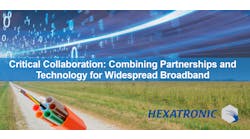Latest from PON/WDM-PON/XGS-PON
Revolutionary Transformation Doesn’t Occur Overnight
This year, we have seen a continued shift to agile network service delivery from Proof of Concept to real-world deployments and a multi-service broadband network. Therefore communication service providers (CSPs) are under pressure to upgrade and transform their networks, pushing to support services beyond simply delivering network connectivity. With an increasing number of connected devices, CSPs are tasked with supporting these high-bandwidth applications and services with a network that offers both Quality of Experience, Quality of Service, and low latency. All while also maintaining the security of the network and systems attached to it.
They need to focus on this network transformation and bring about cost reduction, through the likes of automation and better usage of resources. Open source will be a key component in this transformation, but it is not the only component. The growing adoption of cloud technologies including Software Defined Networking (SDN) and Network Functions Virtualization (NFV) are helping to lessen the demand placed on CSPs’ network architectures, as well as creating new opportunities for more advanced automation in the operational domain. Similarly, virtualization provides an additional opportunity for multiple common resources, such as compute power and storage, to be shared and reused between functions within the network. While virtualization of services and disaggregation are two key trends, we cannot ignore the legacy investment already made in CSPs’ networks, such as traditional access nodes serving large regions of subscribers. No one can afford to revolutionize their network overnight.
“By embracing both open standards and open-source, CSPs can comprehensively transform their networks, reduce their overall costs, and protect their existing investments.”
Only by harnessing the combination of both open-source software and open standards, will global players across the broadband industry be able to realize their full potential and undertake their revolutionary network transformations in a sustained and cost-effective way. Consequently, CSPs need to make sure that any network transformation initiative in one area will also interoperate with other existing platforms and that they have a clear path to interoperability with future deployments of new virtualized and disaggregated systems.
Opening Up the Network
The use of open-source technologies continues to gain traction and is here to stay. For software developers, regardless of the software they are building, open source plays a key role. It provides an invaluable framework, the foundations, or reference implementations for developers to build upon. Participating in an open-source community and utilizing that outcome can be a viable alternative to buying costly proprietary or closed source solutions. Open source allows innovation and collaboration, with the community developed and tested code, resulting in a stable, solid framework for the industry to build upon.
Open-source solutions can allow a service provider’s network to be unique and customizable, and help providers be more selective with their solutions, as well as bring renewed flexibility. However, open source alone does not provide the means to upgrading and future proofing CSPs networks and deployments. Open standards are needed that define lasting, normative descriptions and requirements of the systems, interfaces, or APIs needed by operators.
As next-generation technologies continue to increase the demand on service providers’ network architectures, cloud technologies are notably becoming an important factor for key decision-makers. CSPs are always on the lookout for new opportunities for service deployment, but must also protect their existing network investment, with user experience remaining the ultimate end-goal. The ability to confidently manage the experience of multiple users inside the home or business, across the network, to the device is critical, and the Smart Edge Devices or the Connected Home represents a huge opportunity for CSPs. They continue to vie for the most optimal ways to manage, measure and monetize these opportunities and deliver new services and applications seamlessly to their subscribers.
By utilizing cloud technologies, the decision-making process is sped up for introducing new infrastructure based on user demand, as opposed to being forced into a total replacement strategy. Therefore, CSPs can develop and deploy interoperable cloud-based access networks more easily and unlock a truly virtualized and disaggregated multi-vendor network. As operators embrace these principles to build and scale their networks, it will reduce service providers’ costs and protect their investments.
At the same time, many in the broadband sphere are looking to maximize and improve network performance unequivocally. Open standards help provide efficient and faster ways to effectively manage connected devices. Open standards provide an implementation path, and best of breed of deployment strategy from which every vendor can benefit. Without these standards, it could be a much slower migration process, with CSPs waiting for catalysts that accelerate this network migration.
Open standards therefore play a vital role in aligning the industry on migration approaches and common architecture. In addition to deploying new technologies in their networks (open or closed source), service providers should be looking to streamline the pipeline from development to test to deployment, taking principles from modern dev-ops approaches for cohesive collaboration and integration.
“Consequently, CSPs need to make sure that any network transformation initiative in one area will also interoperate with other existing platforms and that they have a clear path to interoperability with future deployments of new virtualized and disaggregated systems.”
Making Seamless Coexistence a Reality
The Central Office is one area where telcos are adopting disaggregation and virtualization approaches to achieve the associated benefits. From the Central Office (CO) to end-user equipment, operators demand greater service creation and agility, with attention shifting from migrating selected functionality that is locked in existing network elements towards the cloud as virtualized network functions. A cloud-based CO can improve functional automation, flexibility, and workflow, in turn, making networks far more agile and flexible.
Broadband Forum’s Cloud Central Office (CloudCO) initiative is an open architecture to document and define interfaces of the Central Office hosting infrastructure that utilize cloud technologies to support network functions. Accessed through the northbound API, CSPs can access and unlock the CloudCO’s functionality through platform automation and easier integration to their BSS needs. This approach allows the industry to reap the myriad of benefits that cloud technologies promise. The flagship architecture leverages a combination of SDN automation and virtualization and open-source innovation. By combining open-source technologies and standards, it ensures the seamless migration to automated networks with open management and control systems, based on well documented, open, and tested interfaces and API definitions.
Broadband Forum’s host of open broadband projects (e.g., open-source projects) are helping deliver enhanced networking scalability, provide differentiated service offerings, and CSPs to seamlessly streamline their deployments through early reference implementations of the standardized interfaces. Similarly, collaborative efforts between the Open Broadband Labs, such as the University of New Hampshire InterOperability Laboratory (https://www.iol.unh.edu/), CSPs, and the vendor community have enabled rapid prototyping and demonstrations. This collaboration creates the confidence to facilitate early trials and adoptions, development, coexistence and migration, and thanks to these efforts, service providers can easily adopt standardized cloud-based infrastructures.
Utilizing open-source technologies and open standards helps arm CSPs with extra confidence, a clear migration pathway, and protects their legacy investments. Standards development organizations and open-source communities must come together to collaborate and develop agile approaches to capture, document, and support future requirements. The combination of open-source technologies with open standards can deliver a unified ecosystem that allows innovation and value-add services to be offered. It is essential that the entire industry helps develop these new standards to ensure that they are scalable and address a host of varying requirements from global CSPs and vendors alike.
Combining open source with open standards will also bring seamless coexistence of legacy systems and equipment to interoperate with newly introduced technologies. Greater interoperability with new technologies is a necessity in today’s next-generation networks. Expense is eliminated involved in replacing hardware equipment as part of costly cycles. One application or system will not fit all, and the interoperability of all components will serve the industry better.
Unifying the complementary open source and open standards will ensure the efficient delivery of broadband access technologies. Agile and collaborative development supplies global players with turnkey solutions for creating a more seamless user experience for subscribers and adding improved service management and optimization to their overall service offerings. By embracing both open standards and open source, CSPs can comprehensively transform their networks, reduce their overall costs, and protect their existing investments.
ABOUT THE AUTHOR
Lincoln Lavoie is Technical Chair at Broadband Forum. He has more than 22 years of experience in cutting edge, independent laboratory testing of advanced networking technologies. Leadership responsibility for broadband and open-source technologies, including DSL, GPON, G.fast, Wi-Fi, Open Source, Linux, Virtualization and Cloud Native, USP, and TR-069. For more information, please email [email protected] or visit https://www.broadband-forum.org/. Follow the Broadband Forum on Twitter @Broadband_Forum. Follow Lincoln on LinkedIn: https://www.linkedin.com/in/lylavoie/.
Lincoln Lavoie | Technical Chair at Broadband Forum
Lincoln Lavoie is Technical Chair at Broadband Forum. He has more than 22 years of experience in cutting edge, independent laboratory testing of advanced networking technologies. Leadership responsibility for broadband and open-source technologies, including DSL, GPON, G.fast, Wi-Fi, Open Source, Linux, Virtualization and Cloud Native, USP, and TR-069. For more information, please email [email protected] or visit https://www.broadband-forum.org/. Follow the Broadband Forum on Twitter @Broadband_Forum. Follow Lincoln on LinkedIn: https://www.linkedin.com/in/lylavoie/.




